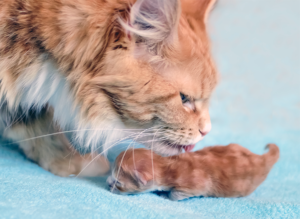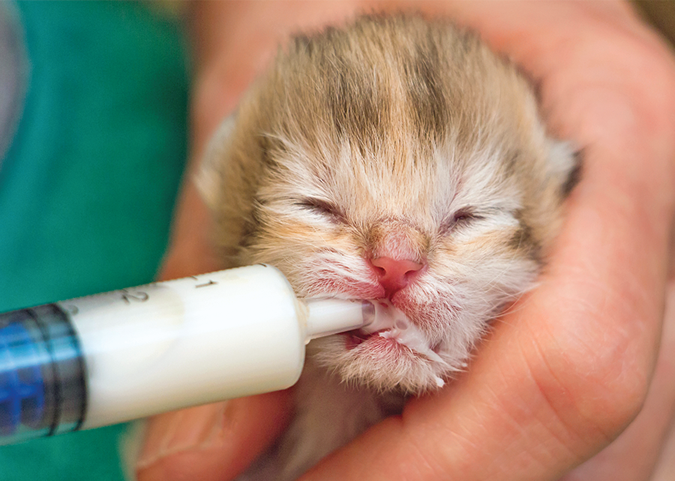Shelters and rescue groups are often overrun with cats in need of homes, especially during the warm months when “kitten season” is in full swing with stray cats reproducing rapidly. While many cats can be processed and housed by the shelter, others require special care and attention for medical or behavioral reasons before they can be placed in a permanent home. Many shelter groups utilize foster homes to give these special-needs kitties the focused attention that they need.
Kitten Care
Fostering kittens can be a ton of fun and very rewarding, but it is also a lot of work and has potential for heartbreak.
Kittens under 4 weeks old require frequent bottle feeding throughout the day and night. Some kittens in critical condition may need to be tube fed (via a small tube that is passed through their mouths into their esophagus). As they get older, they can be gradually switched over to regular food.
Young kittens also require stimulation to urinate and defecate. Normally, the queen does this by licking each kitten’s bottom after they eat. You can simulate this with a warm, damp washcloth, but it takes some practice. They usually begin to urinate and defecate on their own when they switch over to regular food.
Abandoned kittens frequently suffer from upper respiratory infections and other illnesses, and may need to be given medications as well as basic nursing care (cleaning crusty eyes and nose, checking temperature, etc.). Ideally, kittens should stay with their mothers for the first eight to 10 weeks of their lives, so littermates should be kept together until that age if at all possible.
Growing up with their siblings is important for socialization and learning feline social skills. While this does mean adorable kitten pile-ups at bedtime, it can also mean a hoard of kittens climbing your curtains!
Consider what space you will need to contain a litter of kittens safely. A large dog crate is a great starter space for young kittens, but as they grow and become more active, they will need more space to play and exercise. Kitten-proof a room in your house or build an enclosure to keep them contained while providing space for food, water, litterboxes, sleeping spots, and playtime. A covered exercise pen intended for dogs can work well. Their space and toys should also be easy to clean to prevent transmission of infectious disease, especially if you plan to foster more litters in the future.
Medical Cases
Sick cats may require supportive care and/or medication administration. While cats with extensive medical-care needs should ideally be boarded at a veterinary facility or fostered by a veterinary professional, there is still a lot that can be done at home by the average caretaker.
Supportive care includes cleaning crusty eyes and noses, providing warm water bottles wrapped in blankets as a heat source, warming up food to make it more palatable, tube feeding or syringe feeding for cats not eating on their own, and giving subcutaneous fluids (inserting a needle under the skin to administer fluids to help with hydration and electrolyte imbalances). You also may need to monitor the cat’s temperature and body weight.
Medications come in a wide variety of forms and will vary depending on what illness the cat may have. Some cats will eat pills in their food, but others are more discerning and will need to be pilled by hand using either your hand or a pill gun or pill popper (pill guns for cats are quick and easy, with less risk of getting accidentally bitten!).
Liquid medications can be mixed with food or squirted directly into the cat’s mouth. Some medications, such as methimazole for hyperthyroidism, can be formulated as a transdermal gel that is applied to the skin on the inside of the cat’s ear. Eye and ear drops may need to be given. Medicated baths may be required for cats with skin conditions. Diabetic cats will need insulin injections given under the skin (this is usually twice a day).
If you are uncomfortable giving a medication, let the shelter or rescue group know ahead of time so that they can either provide extra training or arrange for you to foster a cat that does not require that medication.
A foster cat may be recovering from injuries from a cat fight or being hit by car. If she has had surgery, she may be wearing a cone or onesie to prevent her from chewing at her stitches. It is your job to make sure she keeps her protective gear on and is still able to do all of her normal cat things such as eating, drinking, and using the litterbox. Drains from abscesses will require daily gentle cleaning. Cats with injuries may also have exercise restrictions or require physical rehabilitation as they recover.
It may be your responsibility to bring the cat in for any follow-up exams. Some conditions, such as ear-mite infections, require minimal follow-up care, while others require more, such as repeated x-rays to monitor bone healing or recheck bloodwork to adjust insulin doses for a newly diagnosed diabetic cat.
Behavioral Cases
Some cats going into foster homes may be physically healthy, but need extra socialization. In most cases, these cats will be fearful and unaccustomed to being handled by humans, or they could have some bad habits from previous homes. It will be your job to keep the cat in a secure space where she has hiding places but can also observe and interact with you on her terms, and to gradually earn her trust and work on basic handling.
You can also do some simple training and behavioral management with a foster cat to help make her more adoptable. Teach her to go into her cat carrier on her own, or discourage play biting behaviors (see “So Your Cat Thinks He’s a Tiger” on p. 3 in this issue).
If a cat placed with you seems to be truly aggressive, she may not be able to be safely placed into a home. Any bites to people or animals should be reported back to the shelter or rescue promptly.

Keep in Mind
When fostering a cat or kitten, it is not your cat. The shelter or rescue group ultimately makes decisions on medical care and how long the cat stays with you. Give feedback on how the cat is doing and ask about anything extra that you think she might benefit from.
If you have cats or other pets of your own, practice good hygiene to prevent illnesses from being spread (ringworm, for example, can be shared among cats, dog, and humans). Keep sick ,foster cats separate from your personal pets, and wash your hands thoroughly after handling them. If you have an immunocompromised cat, it may be best to hold off on fostering. Consult with your veterinarian and the rescue group that you are volunteering with to evaluate any possible risks.
If the foster cat is healthy enough, interacting with your personal pets may be beneficial both for enrichment and to determine whether or not the cat can be placed in a home with other animals. Any introductions for socialization purposes should be done gradually, as if you were adding a new pet to your family. If your dog is rough with or likes to chase cats, it is best to keep them separate.
You may end up a “foster failure” by fully adopting your foster cat, and there is nothing wrong with that!
What Is Fostering?
Fostering a cat is providing a temporary home for a cat or kitten to give her time and care to get her ready to be adopted into a permanent home. While healthy adult cats may sometimes be in need of foster homes, in most cases, the cats selected to go into foster care require some extra care and help to be their best selves. This could mean medical care to recover from an illness or injury, socialization, or bottle feeding of abandoned kittens until they are old enough to be on their own.
In most cases, the shelter or rescue group provides all food and supplies for the foster cat or kittens and covers medical expenses. All you need to do is give your time and open your home.
The shelter or rescue group should also provide you with training so that you are prepared to give appropriate care to the cat or kitten(s) that you will be fostering.
How to Get Started
If you think you would be a good candidate for doing foster care, reach out to your local animal shelter or a feline rescue group in your area. Expect to fill out an application, which will ask for your basic information and likely your pet ownership history and any special areas of expertise, such as hand raising kittens or caring for a diabetic cat. You may be required to live within a certain geographical area to make it easier to check in with the shelter or if they have a relationship with a particular veterinary facility.
Be honest when answering questions. This allows the rescue staff to get an accurate picture of your life and background to determine what cats might be a good fit for you. Don’t feel bad if you don’t have any special experience! Everyone has to start somewhere, and it is much better to get help and training at the beginning than to jump in over your head and potentially jeopardize a cat’s health.
Don’t forget to ask questions yourself. Find out what care and supplies the shelter will cover or provide, and if there is a particular veterinarian that you need to take the cat to. Ask how long cats typically stay in a foster home, and notify them of any vacation plans you might have so that arrangements can be made for the cat’s care.




